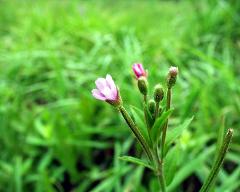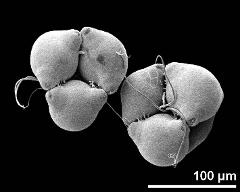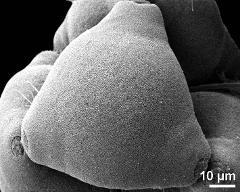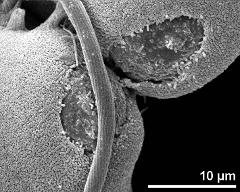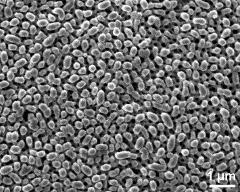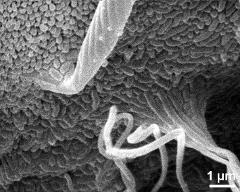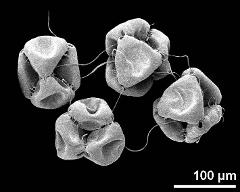Epilobium parviflorum
Taxonomy: Spermatophyta, Myrtales, Onagraceae, Epilobium
Published: 2005-06-01
Pollen Description
Shape, Size and Aperture
pollen unit: tetrad, dispersal unit and peculiarities: tetrad, size (pollen unit): large (51-100 µm), size of hydrated pollen (LM): -, shortest polar axis in equatorial view (LM): -, longest polar axis in equatorial view (LM): -, shortest diameter in equatorial or polar view (LM): -, longest diameter in equatorial or polar view (LM): -, pollen class: -, polarity: heteropolar, P/E-ratio: oblate, shape: -, outline in polar view: triangular, dominant orientation (LM): -, P/E-ratio (dry pollen): oblate, shape (dry pollen): -, outline in polar view (dry pollen): triangular, infoldings (dry pollen): interapertural area sunken, aperture number: 3, aperture type: -, aperture condition: porate, aperture peculiarities: -
Ornamentation and Structure
LM ornamentation LM: -, nexine: -, sexine: -, SEM ornamentation SEM: -, suprasculpture SEM: -, TEM tectum: eutectate, infratectum: -, foot layer: -, endexine: -, intine: -, wall peculiarities: viscin threads, supratectal element: -
Miscellaneous
pollen coatings: absent, reserves in cytoplasm: -, cell number: -, Ubisch bodies: absent
Annotations: Viscin threads rise only from the proximal pole.
Author(s) of diagnosis: Halbritter, H.
Pictures
Picture legend
- flower(s), photographer: Halbritter, H.
- hydrated tetrads - fresh, rehydrated (water) & critical point dried & sputter coated with gold, photographer: Halbritter, H.
- polar view (distal) - fresh, rehydrated (water) & critical point dried & sputter coated with gold, photographer: Halbritter, H.
- apertures and viscin threads - fresh, rehydrated (water) & critical point dried & sputter coated with gold, photographer: Halbritter, H.
- exine surface - fresh, rehydrated (water) & critical point dried & sputter coated with gold, photographer: Halbritter, H.
- insertion of viscin threads - fresh, rehydrated (water) & critical point dried & sputter coated with gold, photographer: Halbritter, H.
- dry tetrads - dry, sputter coated with gold, photographer: Halbritter, H.
Literature
- (1976) An atlas of pollen of the trees and shrubs of Eastern Canada and the adjacent United States. Part III. Leguminosae to Cornaceae. Univ Waterloo Biol Ser 10: 1-37
- (1842) Memoir to determine the use of pollen in natural classification. J Bot 1: 575-601
- (1937) European bee plants and their pollen. Bee Kingdom League, Alexandria, Egypt : 164 pp
- (1984) A practical pollen guide to the British flora. Quaternary Res Bull Technical Guide I: 1-139
- () Pollenformen und Honigherkunftbestimmung. Bücher des Archivs für Bienenkunde, Berlin 2: 1-122
- (1929) Die Pollenformen als Mittel zur Honigherkunftbestimmung. Bücherei für Bienenkunde. Karl Wachholtz Verlag, Neumünster in Holstein X: 1-116, 23 pl
- (1955) Pollen and Spore types of Fuego - Patagonia. Ann Acad Scien Fennicae - Ser A, III 43: 1-14
- (1971) Atlas des pollens des environs d'Istanbul. Istanbul Universitesi, Orman Fakultesi publication : 1-330
- (1982) Starchy and starchless pollen in the Onagraceae. Ann Miss Bot Gard 69: 748-754
- (1967) Studies on the pollen grains of Indian Epilobium L. Palynological Bull Lucknow II & III: 24-29
- (1976) History of vegetation. In: Chapman S.B. (ed) Methods in Plant Ecology. Blackwell Scientific Publ, Oxford : 5-84
- (1885) Epilobium genus a Cl.Ch. Cuisin illustratum. In: Bridel G. (ed) Lausanne : 24 pl
- (1986) Claves para la determinación de los polenes de las principales especies melíferas de la Península Ibérica. Orsis 2: 27-54
- (1942) Lehrbuch der Pollenanalyse. Handbücher der praktischen Vorgeschichtsforschung. Verlag Ferdinand Enke, Stuttgart 3: 195 pp
- (1892) Recherches morphologiques et chimiques sur les grains de pollen. La Cellule 8: 47-80
- (1986) Harmomegathic mechanisms in pollen grains. In: Blackmore S., Ferguson I.K. (eds) Pollen and Spores: Form and Function. Academic Press, London : 137-149
- (1967) Pollen morphology of the Onagraceae. Rev Palaeobot Palynol 3: 163-180
- (1994) Mounting pollen on a thermoplastic adhesive for scanning electron microscopy. Trans Am Microsc Soc 113: 72-79
- (1995) The use of osmium-thiocarbohydrazide for structural stabilization and enhancement of secondary electron images in scanning electron microscopy of pollen. Grana 34: 317-324
- (1953) New Zealand pollen studies. The Monocotyledons. Bull Auckland Inst Mus 3: 1-91
- (1942) New Zealand pollen studies. - I. Key to the pollen grains of families and genera in the native flora. Rec Auckland Inst Mus 2: 280-308
- (1993) Pollen grains of Canadian honey plants. Research Branch, Agriculture and Agri-Food, Canada : 228 pp
- (1987) Fagaceae. In: Valdés B., Díez M.J., Fernández I. (eds) Atlas polínico de Andalucía occidental. Inst de Desarrollo Regional 43, Univ de Sevilla : 94-96
- (1936) Beiträge zur Morphologie und Entwicklungsgeschichte der Pollenkörner. Österr Bot Z 85: 241-269
- (1877) Pollen. Hardwicke & Bogue, London : 92 pp, 24 pl
- (1993) Development of endexine in pollen grains of some Monocots. In: Abstracts. XV International Botanical Congress, Yokohama, Japan
- (1993) Morphology and taxonomic application of orbicules (Ubisch bodies) in the genus Euphorbia. Grana Suppl 2: 26-32
- (1926) Angiospermae. Pflanzenfamilien 14a: 1-167
- (1943) An introduction to pollen analysis. The Ronald Press Company, New York
- (1969) Handbook of Palynology. Morphology - Taxonomy - Ecology. An introduction to the study of pollen grains and spores. Munksgaard édit, Copenhagen : 486 pp
- (1945) Pollen morphology and plant taxonomy V. Svensk Bot Tidskr 39: 286-297
- (1959) Some remarks on pollen and spore illustrations. Pollen et Spores 1: 15-18
- (1970) Topography and non topography in exine stratification. Grana 10: 184-188
- (1971) Notes on the resistance and stratification of the exine. In: Brooks et al. (eds) Sporopollenin. Acad Press, London : 248-255
- (1961) An introduction to a scandinavian pollen flora. Grana Palynologica 2: 3-92
- (1963) An introduction to a scandinavian pollen flora - II. Almquist & Wiksell, Uppsala : 1-89
- (1964) Text book of pollen analysis. Scandinavian University Books, Munksgaard : 1-237
- (1890) Beiträge zur vergleichenden Morphologie der Pollenkörner. Breslau (Thesis) : 1-72
- (1898) A travers les pollens indigènes. Bull Soc Hist Nat Autun 11: 217-238
- (1955) Contribution à l'étude morphologique des grains de pollen. CR Congr Soc Savantes, Lille, 1955, Sect Sci : 377-389
- (1986) Pollen flora of North-West Himalaya. Indian Association of Palynostratigraphers, Lucknow : 181 pp, 29 pl
- (1897) Beiträge zur Biologie und Morphologie des Pollens. Sitzber Böhm Ges Wiss Prag Jahrb XXIII: 1-76
- (1988) Shape and size modification of recent pollen grains under acetolysis. Acta Bot Sinica 30: 655-663
- (1990) The role of the SEM in pollen morphology and plants systematics. In: Claugher D. (ed) Scanning Electron Microscopy in Taxonomy and Functional Morphology. The Systematic Association Special Volume 41: 45-68
- (1842) Observations on the structure of the pollen granule, considered principally in reference to its eligibility as a means of classification. Ann Mag Nat Hist 8 & 9: 92-108, 544-573
- (1925) Nectar producing plants and their pollen. British Bee Journal, London : 1-110
- (1978) Zweierlei Formen der Pollenverkittung bei den Onagraceae. Naturk Jahrb Linz 23: 9-16
- (1978) Vergleichende Untersuchungen zur Entwicklungsgeschichte und Ultrastruktur von Pollenklebstoffen verschiedener Angiospermen. Linzer biol Beitr 9/2: 237-258
- (1980) Ultrastruktur und Entwicklungsgeschichte des Pollenkitts von Euphorbia cyparissias, E. palustris und Mercurialis perennis (Euphorbiaceae). Pl Syst Evol 135: 253-263
- (1980) Zur Stereostruktur der Viscinfäden bei Ericaceen und Onagraceen. Beitr Elektronenmikroskop Direktabb Oberfl 13: 211-216, 2 pl
- (1981) Pollenkitt and viscin threads: their role in cementing pollen grains. Grana 20: 145-152
- (1981) Viscinfäden bei Angiospermen - homologe oder analoge Gebilde? Mikroskopie Wien 38: 85-89, 1 tabl, 1 pl
- (1983) Dissimilar pollen tetrad development in Ericaceae and Onagraceae causes family specific viscin thread configuration. Pl Syst Evol 143: 163-165
- (1974) The pollen loads of the honeybee. Bee Research Association, London : 150 pp
- (1968) Pollen grains of Formosan plants. IV. Taiwania 14: 133-270
- (1972) Pollen flora of Taiwan. National Taiwan Univ, Botany Dept Press : 297 pp
- (1956) Pollen grains of Japan. Hirokawa Publishing Co, Tokyo I-XII: 1-304
- (1952) Atlas zur Bestimmung rezenter und fossiler Pollen und Sporen. Feddes Repert 133: 1-60, 57 pl
- (1969) How to know pollen and spores. Nature series. Wm C Brown Company publisher, Dubuque, Iowa X: 249 pp, 499 figs
- (1988) Apertural development of pollen grains of Clarkia elegans, Epilobium angustifolium and Godetia purpurea (Onagraceae). 7 Int Palynol Congress Brisbane, Abstracts : 82
- (1992) Notes on the exine ultrastructure of Onagraceae and Rhododendroideae (Ericaceae). Grana 31: 119-123
- (1965) Palynologia Madagassica et Mascarenica: Fam. 147-154: Lythraceae-Oenotheraceae. Pollen et Spores 7: 491-507
- (1978) Pollen dicotyledonearum Florae Partis Europaeae USSR. Lamiaceae - Zygophyllaceae. Nauka, Akad Sci USSR, VL Komarov Inst Bot : 184 pp
- (1979) A factor analysis study of the functional significance of Angiosperm pollen. Syst Bot 3: 1-19
- (1968) Eine einfache Methode zur Herstellung von Schnitten durch azetolysierte Pollenkörner. Grana Palynol 8: 252-254
- (1896) Zur Kontroverse über die Einzelligkeit oder Mehrzelligkeit des Pollens der Onagrarieen, Cucurbitaceen und Corylaceen. Jahrb Wiss Bot 7: 34-60
- (1988) Palynotaxonomical affinities of Lythraceae with Myrtales and Onagrales. Science and Culture 54: 170-172
- (1969) Scanning electron photomicrographs of southwestern pollen grains. J Arizona Acad Sci 5: 147-176
- (1973) Key to the Quaternary pollen and spores of the great lakes region. Royal Ontario Museum, Toronto, Canada : 61 pp
- (1963) Cercetari palinologice asupra microsporilordin Familie Onagraceae. Acta Bot Horti Bucuresti 1961-1962 1: 435-457
- (1993) Pollen grains of New Zealand Dicotyledonous Plants. Lincoln NZ: Manaki Whenua Press, New Zealand : 200 pp
- (1834) Über den Bau und die Formen der Pollenkörner. Beiträge zur Anatomie und Physiologie der Gewächse. Erstes Heft. Bern 4: 130 pp, 6 pl
- (1835) Sur la structure et les formes des graines de pollen. Ann Sci Nat, Ser 2 3: 148-180, 220-236, 304-346
- (1978) An illustrated guide to pollen analysis. Hodder & Stoughton Ltd, Kent : 133 pp
- (1991) Pollen analysis. Blackwell Scientific Publications. Second Edition : 216 pp
- (1976) Flora und palynomorphs of Alaska. Orion Press, Tokyo : 367 pp
- (1966) A new taxonomy for Epilobium angustifolium L. (Onagraceae). Brittonia 18: 167-188
- (1994) Keys for the pollen of Ashiu, Central Japan. Contrib Biol Lab Kyoto Univ 28: 261-355
- (1965) Pollen grains of Western Himalayan Plants. Asia Monographs, India 1 VIII: 1-102
- (1980) Diagnostic characters of pollen grains of Japan - I & II. Spec Publ Osaka Mus Nat Hist 12: 157 pl
- (1980) Diagnostic characters of pollen grains of Japan - I & II. Spec Publ Osaka Mus Nat Hist 13: 91 pp
- (1985) On the pollen morphology of common ground vegetation of Lava, Rechila and Lulagaoun, Darjeeling District. Geophytology 15: 67-75
- (1901) Recherches morphologiques sur le pollen des Dialypétales. Journ de Bot : 15-166, 194-204, 218-222, 419-422
- (1983) Half pseudocolpi, a unique feature of Olinia (Oliniaceae) pollen. Amer J Bot 70: 469-473
- (1961) Pollen. Talleres graficos DCP, Gerona
- (1950) Analyse pollinique (Traduction par E. Boltenhagen). Annales du Service d'Information géologique du BRGGM 24: 1-435
- (1867) Über das Entstehen und die Bildung der kreisrunden Öffnungen in der äußeren Haut des Blütenstaubes, nachgewiesen am Bau des Blütenstaubes der Cucurbitaceen und Onagrarien. Bonn
- (1994) Onagraceae Juss Circaeeae DC., Hauyeae Raimann, Epilobieae Spach. World Pollen and Spore Flora 19: 1-38
- (2003) Onagraceae. The Northwest European Pollen Flora 67. Rev Palaeobot Palynol 123: 107-161
- (1977) Generic and sectional delimitation in Onagraceae tribe Epilobieae. Ann Miss Bot Gard 63: 326-340
- (1992) Pollen et spores d'Europe et d'Afrique du Nord. Laboratoire de Botanique historique et Palynologie, Marseille : 520 pp, 446 pl
- (1971) Implications on the nature of Sporopollenin based upon pollen development. In: Brooks et al. (eds) Sporopollenin. Academic Press, London : 174-219
- (1971) Resolution of channels in the exine by translocation of colloidal iron. 29th Ann Proc Electron Microscopy Soc Amer : 352-353
- (1973) Formation of pollen exine bacules and microchannels on a glycocalyx. Grana 13: 129-138
- (1975) Lipopolysaccaride embedded within the exine of pollen grains. 33rd Ann Proc Electron Microscopy Soc Amer : 572-573
- (1975) Germinal apertural formation in pollen. Taxon 24: 17-25
- (1976) Dynamic changes in pollen wall morphology. Linn Soc Symp Ser 1: 39-66
- (1979) The origin, ontogeny and evolution of the exine. Proc IV Int Palynol Conf Lucknow 1: 126-136, 11 pl
- (1981) Pollen wall characters with emphasis upon applicability. Nord J Bot 1: 357-380
- (1983) Plasma membrane surface processes as construction units of the exine. In: Fertilization and embryogenesis in ovulated plants. VEDA, Bratislava : 83-87
- (1987) Plasmodesmata-like processes of tapetal cells. La Cellule 74: 229-241
- (1988) Substructure within the endexine, an interpretation. J Palynol 23-24: 29-42
- (1990) The fundamental structure of the pollen exine. Pl Syst Evol 5: 13-29
- (1995) Are the endexines of pteridophytes, gymnosperms and angiosperms structurally equivalent? Rev Palaeobot Palynol 85: 13-34
- () Are exine reception systems of Fagus and Pinus structurally the same? Diversity in exine development. In: Chanda S. (ed), Current Perspectives in palynological research. J Palynol, Silver Jubilee Commemoration Volume 27: 323-344
- (1996) Exine origin, development and structure in pteridophytes, gymnosperms, and angiosperms. In: Jansonius J., McGregor D.C. (eds) Palynology: principles and applications. Amer Assoc Stratigr Palynol Foundation 1: 443-462
- (1996) Structure of the exine of Epilobium angustifolium (Onagraceae). Grana 35: 79-86
- (1983) Fine structure of viscin threads in Epilobium angustifolium. J Ultrastruct Res 85: 112
- (1981) Substructure in exines of Artemisia vulgaris (Asteraceae). Rev Palaeobot Palynol 35: 1-38
- (1983) Viscin threads considered as connective structures between pollen grains and tapetal cells. Fertilization and embryogenesis in ovulated plants. VEDA, Bratislava : 89-92
- (1979) Pollen wall fibrils lacking primary receptors for sporopollenin. 37th Ann Proc Electron Microscopy Soc Amer : 340-341
- (1970) Migration of Lanthanum through the pollen wall. 28th Annual Proceedings EMSA : 2 pp
- (1971) Migration of Lanthanum through the pollen wall. Cytobiologie 3: 1-12
- (1970) Influence of Pinocystosis and membrane specializations on pollen wall form. Grana 10: 3-12
- (1977) Selective destruction of the exine of pollen grains. Geophytology 7: 1-23
- (1993) Exine receptors. Grana 2: 21-25
- (1981) Pollen identification for bee keepers. Univ College Cardiff Press : 111 pp
- (1994) Alpine plants of Western Himalaya (a palynotaxonomical approach). Bishen Singh Mahendra Pal Singh, Dehra Dun, India : 176 pp
- (1973) Palynomorphs of Japanese plants. Spec Publ Osaka Mus Nat Hist 5: 1-60
- (1978) An ultrastructural study of viscin threads in Onagraceae pollen. Pollen et Spores XX: 5-143
- (1975) The evolution of pollen tetrads in Onagraceae. Amer J Bot 62: 6-35
- (1976) Ultrastructural survey of Onagraceae pollen. Linn Soc Symp Ser 1: 447-479
- (1988) Adaptability of scanning electron microscopy to studies of pollen morphology. Aliso 12: 119-175
- (1962) On spore and pollen-morphology of recent plants in the USSR. Moskow Univ, Moskow : 256 pp
- (1958) Pollen of the Arctic plants. Nauka, Akad Sci USSR, VL Komarov Inst Bot : 245-292, 24 tabl
- (1981) Kartoteka Palynologiczna Roslin Polskich. Opolskie Towarzystwo Przyjaciol Nauk, Zeszyty Przyrodnicze 21: 257-266
- (1965) Kartoteka Palynologiczna Roslin Polskich. Opolskie Towarzystwo Przyjaciol Nauk, Zeszyty Przyrodnicze 5: 31-50
- (1984) Fam. 147-154. Microscopie électronique à balayage et addenda. In: Straka H. (ed) Palynologia Madagassica et Mascarenica, Addenda and REM : 53-71
- (1930) On the origin of the number and arrangement of the places of exit on the surface of pollen grains. Rec Travaux Bot Néerlandais 2: 1-82
- (1975) Die Morphologie des Pollens und deren Bedeutung für die Bestäubung der Bienenpflanzen von Rumänien. CR III Symp International sur la pollinisation. Prague, 1974. Bull Tech apicole (Suppl) 2: 293-316
- (1990) Monografia polenului florei din România. Editura Academiei Române III: 98 pp, 94 pl
- (1994) La morphologie pollinique: contraintes et selection. In: Sciences de la Vie. Lettre des Départements scientifiques du CNRS 45: 9 pp
- (1966) Pollen morphology of Onagraceae. Pollen et Spores 8: 9-36
- (1983) Palynomorphs of Japanese Alpine plants - I. In: Ecosystem analysis in the alpine belt in the Central mountain region of Japan, II. Fac Liberal Arts, Shinshu Univ : 16-34
- (1994) Estudio del sistema apertural y estructura de la esporodermis en Polygala L. In: Polen y esporas: Contribución a su conocimiento. VIII Simposio de Palinologia, Tenerife : 125-130
- (1958) Palynologie africaine II. Bull IFAN 20: 753-760
- (1950) Recherches sur la phylogénie des Abiétinées d'après leurs grains de pollen. Trav Lab For Toulouse II: 1-182
- (1988) Palynology. In: van der Meijden R. (ed) Polygalaceae. Flora Malesiana, Ser 1 10: 457 pp
- (1986) Contribución al estudio polínico de Polygala L. (Polygalaceae) en la Península Ibérica. An Jard Bot Madrid 42: 377-388
- (1960) Pollen grains of China. : 276 pp
- (1995) Pollen flora of China. Institute of Botany, Academia Sinica, Beijing. Second edition. : 461 pp, 205 pl
- (1995) Pollen morphology of Bupleurum L. from Sino-Himalaya and it systematic significance. Chin J Appl Environ Biol 1: 34-43
- (1988) Morphologie florale en microscopie électronique á balayage. Editions des Conservatoire et Jardin Botaniques de Genéve : 167 pp
- (1982) Actinidiaceae, Aquifoliaceae, Araliaceae, Combretaceae, Erythroxylaceae, Hydrocaryaceae, Ochnaceae, Onagraceae, Verbenaceae, Restionaceae. In: Angiosperm pollen flora of tropic and subtropic China. Inst Bot South China : 17-18, 48-58, 97-100, 125-126, 180-181, 249, 256-260, 390-400, 427-428
- (1979) Atlas de pollens de Côte d'Ivoire. Initiat Doc Tech ORSTOM 40: 1-40, 25 pl
Copyright and Citation
Cite this publication as:
Halbritter H. 2005. Epilobium parviflorum. In: PalDat - A palynological database. https://pc8.botanik.univie.ac.at/pub/Epilobium_parviflorum/110071;jsessionid=DCA5441743C871075E9EA206BB60A5B7; accessed 2025-01-10

